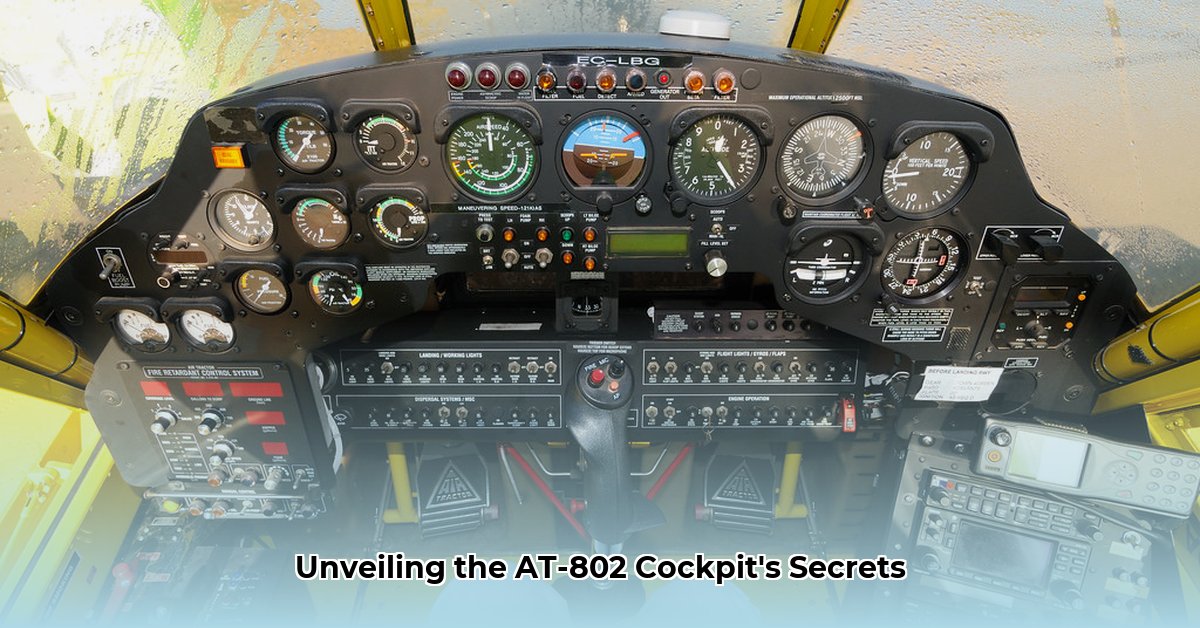
Stepping into the cockpit of an Air Tractor AT-802 reveals distinct operational philosophies depending on the model: the AT-802A and the AT-802U. This article details their differences, highlighting implications for pilots and operations. For more Air Tractor models, see the AT-502B information.
The AT-802A Cockpit: A Focused Workhorse
The AT-802A cockpit prioritizes straightforward functionality. Traditional gauges and uncomplicated controls dominate the design. This simplicity ensures ease of learning and operation, providing pilots a direct, hands-on connection with the aircraft's systems. Many pilots appreciate this direct, intuitive feel, fostering a strong sense of control. But this simplicity also means a heavier reliance on pilot skill and experience, especially in challenging weather conditions. It's a robust, reliable platform for straightforward tasks, but lacks the sophisticated technological assistance of its counterpart.
The AT-802U Cockpit: A Modernized Flight Deck
The AT-802U offers a stark contrast. Its state-of-the-art digital flight deck, centered around a comprehensive Garmin avionics suite, provides pilots with a wealth of information. Crisp digital displays, integrated flight management systems, and the L3 ForceX Widow mission management system streamline mission planning and execution. This technology significantly enhances safety and operational efficiency, akin to having a skilled co-pilot constantly monitoring systems. However, this technological advancement necessitates more extensive pilot training and understanding. While incredibly advantageous, the enhanced capabilities require a substantial investment in training and expertise.
Comparing the Cockpits: A Detailed Analysis
The table below summarizes key differences:
| Feature | AT-802A | AT-802U |
|---|---|---|
| Avionics | Analog gauges, simple instruments | Integrated Garmin avionics, L3 ForceX system |
| Displays | Traditional needles and dials | Modern digital displays, intuitive interfaces |
| Mission Management | Primarily manual, pilot-driven | Automated features, advanced mission planning |
| Complexity | Low, easy to learn | High, requires more substantial training |
| Typical Mission Focus | Large-scale agricultural operations | Precision agriculture, specialized operations |
| Payload Capacity | Generally higher | Potentially lower (direct comparison needed) |
Isn't the shift towards digital avionics a significant factor in pilot workload reduction? Studies show automation significantly decreases pilot fatigue during extended operations.
Key Differences and Their Operational Impact
The core difference stems from their design philosophies. The AT-802A prioritizes raw power and maximum payload for large-scale operations, while the AT-802U emphasizes precision and efficiency through advanced technology, ideal for specialized tasks. This impacts pilot workload; the AT-802U's automation significantly reduces workload compared to the AT-802A, translating to increased productivity and potentially reduced fatigue. The AT-802A, while a dependable workhorse, demands more from the pilot, particularly in challenging conditions. The AT-802U is a more sophisticated tool, requiring considerable training, but offering increased precision and support.
The Future of Air Tractor AT-802 Cockpits
Air Tractor continuously innovates. Future enhancements to both models will likely include increased automation, improved situational awareness, and enhanced safety systems. Discussions around enhanced connectivity, improved data management, and even autonomous capabilities are ongoing. The AT-802 cockpit's evolution will adapt to the changing needs of agricultural aviation, constantly pushing for improved flight safety and operational efficiency.
Comparing Operational Costs: AT-802A vs. AT-802U
Understanding operational cost disparities between the AT-802A and AT-802U is vital for operators. While sharing lineage, distinct features impact overall running expenses.
Key Cost Factors:
- Fuel Consumption: Precise fuel burn data, considering payload and mission profiles, are essential for comparison.
- Maintenance: The AT-802U's advanced systems may require specialized maintenance, impacting costs.
- Pilot Training: The AT-802U demands more extensive training, increasing overall costs.
- Insurance: Insurance premiums vary depending on aircraft model, operational conditions, and payload.
- Depreciation: The AT-802U's newer technology may impact its depreciation rate.
A Step-by-Step Cost Comparison Methodology:
- Data Gathering: Collect detailed specifications from reputable sources for both models.
- Operational Profile Definition: Specify typical missions for each aircraft (e.g., annual flight hours, average payload).
- Cost Calculation: Estimate annual operational costs for each aircraft, encompassing fuel, maintenance, labor, insurance, and depreciation.
- Sensitivity Analysis: Assess how variations in factors like fuel prices and maintenance frequency affect costs.
- Comparative Analysis: Compare total annual operational costs, identifying key cost drivers and differences.
Key Takeaway: A thorough cost analysis, factoring in all variables, is crucial for informed decision-making. Fuel efficiency, maintenance schedules, pilot training, and insurance are key factors to consider.